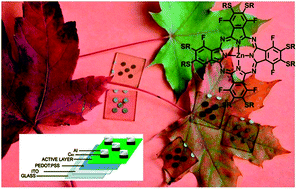Controlling morphology and molecular packing of alkane substituted phthalocyanine blend bulk heterojunction solar cells†
Abstract
Systematic changes in the exocyclic substitution of a core

* Corresponding authors
a
Department of Chemistry, Hunter College of The City University of New York, New York, New York 10065, USA
E-mail:
Cdrain@hunter.cuny.edu
b
Photon Sciences Division BLDG 728M, Brookhaven National Laboratory, Upton, New York 11973, USA
E-mail:
DiMasi@bnl.gov
c Center for Functional Nanomaterials, Brookhaven National Laboratory, Upton, New York 11973, USA
d The Rockefeller University, New York, New York 10065, USA
Systematic changes in the exocyclic substitution of a core

 Please wait while we load your content...
Something went wrong. Try again?
Please wait while we load your content...
Something went wrong. Try again?
M. J. Jurow, B. A. Hageman, E. DiMasi, C. Nam, C. Pabon, C. T. Black and C. M. Drain, J. Mater. Chem. A, 2013, 1, 1557 DOI: 10.1039/C2TA00415A
To request permission to reproduce material from this article, please go to the Copyright Clearance Center request page.
If you are an author contributing to an RSC publication, you do not need to request permission provided correct acknowledgement is given.
If you are the author of this article, you do not need to request permission to reproduce figures and diagrams provided correct acknowledgement is given. If you want to reproduce the whole article in a third-party publication (excluding your thesis/dissertation for which permission is not required) please go to the Copyright Clearance Center request page.
Read more about how to correctly acknowledge RSC content.
 Fetching data from CrossRef.
Fetching data from CrossRef.
This may take some time to load.
Loading related content
